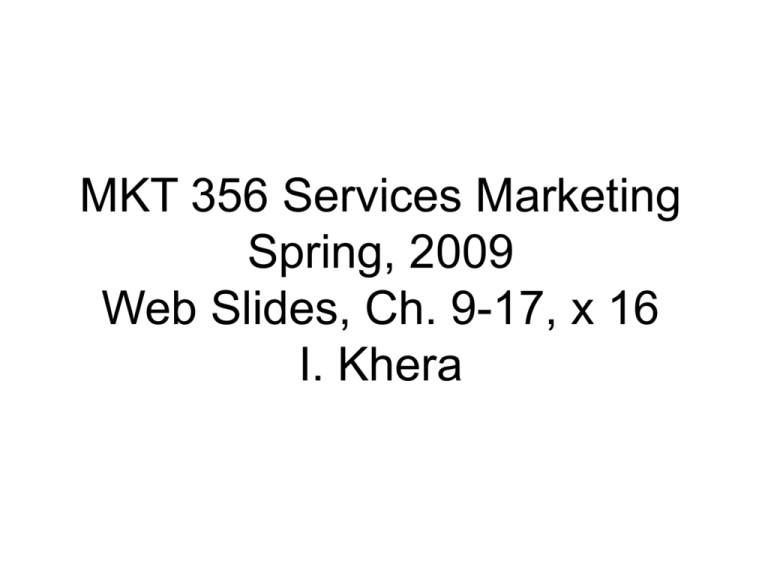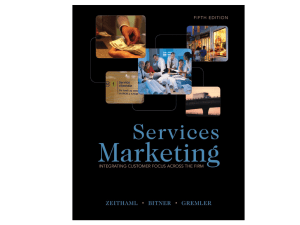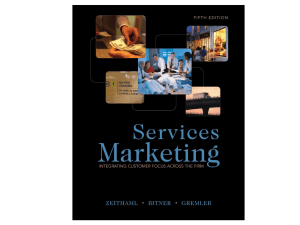
MKT 356 Services Marketing
Spring, 2009
Web Slides, Ch. 9-17, x 16
I. Khera
Chapter
Service Innovation and Design
9
• Challenges of Service Innovation and
Design
• New Service Development Processes
• Types of Service Innovations
• Stages in Service Innovation and
Development
• Service Blueprinting
• High-Performance Service Innovations
McGraw-Hill/Irwin
Copyright © 2009 by The McGraw-Hill Companies, Inc. All rights reserved.
Risks of Relying on Words Alone to
Describe Services
• Oversimplification
• Incompleteness
• Subjectivity
• Biased Interpretation
Types of Service Innovations
• major or radical innovations
• start-up businesses
• new services for the currently served market
• service line extensions
• service improvements
• style changes
See Exhibits 9-1, 9-2, 9-3
Service Blueprint Components
Customer Actions
line of interaction
Visible Contact Employee Actions
line of visibility
Invisible Contact Employee Actions
line of internal interaction
Support Processes
Service Blueprint Components
See Exhibits 9-5, 9-6 and 9-7
Application of Service Blueprints
• New Service Development
– concept development
– market testing
• Supporting a “Zero Defects” Culture
– managing reliability
– identifying empowerment issues
• Service Recovery Strategies
– identifying service problems
– conducting root cause analysis
– modifying processes
Uses of Blueprints
• Service Marketers
– creating realistic
customer expectations:
• service system design
• promotion
• Operations
Management
– rendering the service
as promised:
• managing fail points
• training systems
• quality control
• Human Resources
Management
– empowering the human
element:
• job descriptions
• selection criteria
• appraisal systems
• System Technology
– providing necessary tools:
• system specifications
• personal preference
databases
Benefits of Service Blueprinting
• Provides a platform for innovation.
• Recognizes roles and interdependencies among
functions, people, and organizations.
• Facilitates both strategic and tactical innovations.
• Transfers and stores innovation and service knowledge.
• Designs moments of truth from the customer’s point of
view.
• Suggests critical points for measurement and feedback
in the service process.
• Clarifies competitive positioning.
• Provides understanding of the ideal customer
experience.
Common Issues in Blueprinting
• Clearly defining the process to be blueprinted
• Clearly defining the customer or customer
segment that is the focus of the blueprint
• Who should “draw” the blueprint?
• Should the actual or desired service process be
blueprinted?
• Should exceptions/recovery processes be
incorporated?
• What is the appropriate level of detail?
• Symbology
• Whether to include time on the blueprint
Tangible Cues or Indicators of Quality
•
•
•
•
•
•
•
Exterior and Interior Design
Presentation of Food/Drinks
Appearance of Staff
Cleanliness of Tables, Utensils
Cleanliness of Restrooms
Location of Restaurant
Appearance of Surrounding Customers
Possibility of Standardization
• Hostess Greeting
• Pre-Prepared Sauces (Mild, Medium and
Hot)
• Time Standards
• Food and Drink Quality Standards
• Bill Standards
Potential Fail Points and Fixability
• Bar
– train to make drinks; create ample seating space for wait area overflow
• Food
– revise food presentation; create quality control checks to ensure order is
correct before delivering to customer
• Staff
– training; set number of times to check-in on customers; behavioral and
attitude guidelines; dress code
• Billing
– standards for when to bring bill, how to deliver, when to pick-up, how
quickly to process transaction; ensure one fortune cookie per customer
• Cleanliness
– standards for amount of time it takes to clear and clean tables; regular
restroom checks
Customer-Defined Service
Standards
Chapter
10
• Factors Necessary for Appropriate Service
Standards
• Types of Customer-Defined Service
Standards
• Development of Customer-Defined Service
Standards
McGraw-Hill/Irwin
Copyright © 2009 by The McGraw-Hill Companies, Inc. All rights reserved.
Service Standards
Standards are based on the most important customer
expectations and reflect the customer’s view of these expectations.
CustomerDefined
Standards
SOURCES
Customer Expectations
Customer Process Blueprint
Customer Experience
Observations
CompanyDefined
Standards
SOURCES
Productivity Implications
Cost Implications
Company Process Blueprint
Company View of Quality
Standards…
HARD STANDARDS AND MEASURES
Things that can be counted, timed,
or observed through audits (time,
numbers of events)
SOFT STANDARDS AND MEASURES
Opinion-based measures that cannot
be observed and must be collected by
talking to customers (perceptions, beliefs)
See Exhibits 10-1 and 10-2
What Customers Expect: Getting to
Actionable Steps
Process for Setting CustomerDefined Standards
See Exhibit 10-5
Hard (Mostly) Service Standards at
Ford
• Appointment available within one day of
customer’s requested service day
• Write-up begins within four minutes
• Service needs are courteously identified,
accurately recorded on repair order and verified
with customer
• Service status provided within one minute of
inquiry
• Vehicle serviced right on first visit
• Vehicle ready at agreed-upon time
• Thorough explanation given of work done,
coverage and charges
Soft Standards at Toyota in
Japan
• Standards for salespeople
patterned after samurai behaviors:
– assume the samurai warrior’s
“waiting position” by leaning five to
ten degrees forward when a customer
is looking at a car
– stand with left hand over right, fingers
together and thumbs interlocked, as
the samurais did to show they were
not about to draw their swords
– display the “Lexus Face,” a closedmouth smile intended to put
customers at ease
More Soft Standards at Toyota
in Japan
• Standards for salespeople patterned
after samurai behaviors:
– when serving coffee or tea, kneel on the
floor with both feet together and both
knees on the ground
– bow more deeply to a customer who has
purchased a car than a casual window
shopper
– stand about two arms’ lengths from
customers when they are looking at a car
and come in closer when closing a deal
– point with all five fingers to a car door’s
handle, right hand followed by left, then
gracefully open the door with both hands
Standards at Four Seasons
• Seven Service Culture • Core Worldwide
Service Operating
Standards
Standards
1. Smile
2.
3.
4.
5.
6.
7.
•
•
•
•
Reservations
Eye
Hotel Arrival
Recognition
Messages and Paging
Voice
Guest Room Evening
Informed
Service
Clean
• Breakfast
Everyone
• Room
Exceptions are permitted if
they make local sense
Ritz-Carlton’s SQI Index
SQI Defects
Points
1. Missing Guest Preferences
10
2. Unresolved Difficulties
50
3. Inadequate Guestroom Housekeeping
1
4. Abandoned Reservation Calls
5
5. Guestroom Changes
5
6. Inoperable Guestroom Equipment
5
7. Unready Guestroom
10
8. Inappropriate Hotel Appearance
5
9. Meeting Event Difficulties
5
10. Inadequate Food/Beverage
1
11. Missing/Damaged Guest Property/Accidents
50
12. Invoice Adjustment
3
Physical Evidence and the
Servicescape
Chapter
11
•
•
•
•
Physical Evidence
Types of Servicescapes
Strategic Roles of the Servicescape
Framework for Understanding Servicescape
Effects on Behavior
• Guidelines for Physical Evidence Strategy
McGraw-Hill/Irwin
Copyright © 2009 by The McGraw-Hill Companies, Inc. All rights reserved.
Objectives for Chapter 11:
Physical Evidence and the Servicescape
• Explain the profound impact of physical evidence,
particularly the servicescape, on customer perceptions
and experiences.
• Illustrate differences in types of servicescapes, the
roles played by the servicescape, and the implications
for strategy.
• Explain why the servicescape affects customer and
employee behavior, using a framework based in
marketing, organizational behavior, and environmental
psychology.
• Present elements of an effective physical evidence
strategy.
See Exhibits 11-1, 11-2 and 11-3
Roles of the Servicescape
• Package
– conveys expectations
– influences perceptions
• Facilitator
– facilitates the flow of the service delivery process
• provides information (how am I to act?)
• facilitates the ordering process (how does this work?)
• facilitates service delivery
• Socializer
– facilitates interaction between:
• customers and employees
• customers and fellow customers
• Differentiator
– sets provider apart from competition in the mind of the consumer
A Framework for Understanding Environment-User
Relationships in Service Organizations
Guidelines for Physical Evidence
Strategy
• Recognize the strategic impact of physical
evidence.
• Blueprint the physical evidence of service.
• Clarify strategic roles of the servicescape.
• Assess and identify physical evidence
opportunities.
• Be prepared to update and modernize the
evidence.
Part 5
DELIVERING AND
PERFORMING
SERVICE
Key Factors Leading to Provider
Gap 3
Employees’ Roles in Service
Delivery
Chapter
12
• Service Culture
• The Critical Importance of Service
Employees
• Boundary-Spanning Roles
• Strategies for Delivering Service Quality
Through People
• Customer-Oriented Service Delivery
McGraw-Hill/Irwin
Copyright © 2009 by The McGraw-Hill Companies, Inc. All rights reserved.
Service Culture
“A culture where an appreciation for good
service exists, and where giving good
service to internal as well as ultimate,
external customers, is considered a
natural way of life and one of the most
important norms by everyone in the
organization.”
- Christian Grönroos (1990)
The Critical Importance of
Service Employees
•
•
•
•
•
•
•
Every encounter counts
Employees are the service.
Every employee can make a difference
They are the organization in the customer’s eyes.
They are the brand.
They are marketers.
Through their actions, all employees shape the brand
• Their importance is evident in:
– the services marketing mix (people)
– the service-profit chain
– the services triangle
The Services Marketing Triangle
Aligning the Triangle
• Organizations that seek to provide
consistently high levels of service
excellence will continuously work to align
the three sides of the triangle.
• Aligning the sides of the triangle is an
ongoing process.
Services Marketing Triangle
Applications Exercise
• Focus on a service organization. In the context
you are focusing on, who occupies each of the
three points of the triangle?
• How is each type of marketing being carried out
currently?
• Are the three sides of the triangle well aligned?
• Are there specific challenges or barriers in any
of the three areas?
Making Promises
•
•
•
•
•
•
Understanding customer needs
Managing expectations
Traditional marketing communications
Sales and promotion
Advertising
Internet and web site communication
Keeping Promises
• Service delivery
– Reliability, responsiveness, empathy, assurance,
tangibles, recovery, flexibility
• Face-to-face, telephone & online interactions
• The Customer Experience
• Customer interactions with sub-contractors
or business partners
• The “moment of truth”
Enabling Promises
• Hiring the right people
• Training and developing people to deliver
service
• Employee empowerment
• Support systems
• Appropriate technology and equipment
• Rewards and incentives
Ways to Use the Services
Marketing Triangle
• Overall Strategic
Assessment
– How is the service
organization doing on
all three sides of the
triangle?
– Where are the
weaknesses?
– What are the
strengths?
• Specific Service
Implementation
– What is being promoted
and by whom?
– How will it be delivered
and by whom?
– Are the supporting
systems in place to
deliver the promised
service?
See Exhibit 12-2
Service Employees
• Who are they?
– Boundary Spanners: Interact with both internal
and external constituents
• What are these jobs like?
– emotional labor
– many sources of potential conflict
• person/role
• organization/client
• interclient
– quality/productivity tradeoffs
Human Resource Strategies for Delivering
Service Quality through People
How Employee Satisfaction Drives Productivity
and Customer Satisfaction at Wegmans
The grocery chain paid over $54 million for college scholarships for 17,500+
employees over the past 20 years.
Wegmans did not hesitate to send cheese manager Terri Zodarecky on a
ten-day sojourn to cheesemakers in Europe.
The firm gives employees flexibility to deliver great customer satisfaction.
How can this be justified?
How does this affect
performance?
• Wegmans’ labor costs are 15-17% of sales,
compared with 12% for industry.
• But annual turnover is just 6% (19% for similar
grocery chains).
• 20% of employees have 10+ years of service.
• This in an industry where turnover costs can
exceed annual profits by more than 40%.
• Wegmans’ operating margins are 7.5%, double
what the big grocers earn.
• Sales per square foot are 50% higher than
industry average.
Empowerment
• Benefits:
– quicker responses to
customer needs during
service delivery
– quicker responses to
dissatisfied customers
during service recovery
– employees feel better about
their jobs and themselves
– employees tend to interact
with warmth/enthusiasm
– empowered employees are
a great source of ideas
– great word-of-mouth
advertising from customers
• Drawbacks:
– potentially greater dollar
investment in selection and
training
– higher labor costs
– potentially slower or
inconsistent service delivery
– may violate customers’
perceptions of fair play
– employees may “give away
the store” or make bad
decisions
Traditional Organizational Chart
Manager
Supervisor
Front-line
Employee
Front-line
Employee
Front-line
Employee
Supervisor
Front-line
Employee
Front-line
Employee
Customers
Front-line
Employee
Front-line
Employee
Front-line
Employee
Customer-Focused Organizational
Chart
Inverted Services Marketing
Triangle
Customers’ Roles in Service
Delivery
Chapter
13
• The Importance of Customers in Service
Cocreation and Delivery
• Customers’ Roles
• Self-Service Technologies—The Ultimate
in Customer Participation
• Strategies for Enhancing Customer
Participation
McGraw-Hill/Irwin
Copyright © 2009 by The McGraw-Hill Companies, Inc. All rights reserved.
See Exhibit 13-1
How Customers Widen the Service
Performance Gap
• Lack of understanding of their roles
• Not being willing or able to perform their roles
• No rewards for “good performance”
• Interfering with other customers
• Incompatible market segments
Importance of Other (“Fellow”) Customers
in Service Delivery
• Other customers can detract from satisfaction:
–
–
–
–
disruptive behaviors
overly demanding behaviors
excessive crowding
incompatible needs
• Other customers can enhance satisfaction:
– mere presence
– socialization/friendships
– roles: assistants, teachers, supporters, mentors
Customer Roles in Service
Delivery
Productive Resources
Contributors to
Service Quality and
Satisfaction
Competitors
See Exhibit 13-1
Customers as Productive
Resources
• customers can be thought of as “partial
employees”
– contributing effort, time, or other resources to the
production process
• customer inputs can affect organization’s
productivity
• key issue:
– should customers’ roles be expanded? reduced?
Customers as Contributors to
Service Quality and Satisfaction
• Customers can contribute to:
– their own satisfaction with the service
• by performing their role effectively
• by working with the service provider
– the quality of the service they receive
• by asking questions
• by taking responsibility for their own satisfaction
• by complaining when there is a service failure
Customers as Competitors
• customers may “compete” with the service
provider
• “internal exchange” vs. “external exchange”
• internal/external decision often based on:
–
–
–
–
–
–
–
expertise capacity
resources capacity
time capacity
economic rewards
psychic rewards
trust
control
See Exhibit 13-2
Strategies for Enhancing customer
Participation
• Define customers’ jobs
– helping oneself
– helping others
– promoting the company
• Recruit, educate, and reward customers
–
–
–
–
recruit the right customers
educate and train customers to perform effectively
reward customers for their contributions
avoid negative outcomes of inappropriate customer
participation
• Manage the customer mix
See Exhibit 13-2
Chapter
Delivering Service Through
14
Intermediaries & Electronic Channels
•
•
•
•
•
•
•
Service Distribution
Direct or Company-Owned Channels
Franchising
Agents and Brokers
Electronic Channels
Common Issues Involving Intermediaries
Strategies for Effective Service Delivery
Through Intermediaries
McGraw-Hill/Irwin
Copyright © 2009 by The McGraw-Hill Companies, Inc. All rights reserved.
Service Provider Participants
• Service principal (originator)
– creates the service concept
• (like a manufacturer)
• Service deliverer (intermediary)
– entity that interacts with the customer in the
execution of the service
• (like a distributor/wholesaler)
Services Intermediaries
• Franchisees
– service outlets licensed by a principal to deliver a
unique service concept it has created
• e.g., Jiffy Lube, Blockbuster, Holiday Inns, McDonald’s
• Agents and Brokers
– representatives who distribute and sell the services of
one or more service suppliers
• e.g., travel agents, independent insurance agents
• Electronic Channels
– all forms of service provision through electronic
means
• e.g., ATMs, university video courses, TaxCut software
Benefits and Challenges for
Franchisors of Service
Benefits
• Leveraged business
format for greater
expansion & revenues
• Consistency in outlets
• Knowledge of local
markets
• Shared financial risk &
more working capital
Challenges
• Difficult to maintain &
motivate franchisees
• Highly publicized
disputes & conflicts
• Intermediaries control
customer relationship
Benefits and Challenges for
Franchisees of Service
Benefits
• An established
business format
• International, national,
or regional brand
marketing
• Minimized risk of
starting a business
• Poorly capitalized or
managed franchisor
Challenges
• Encroachment of other
outlets into franchised
territories
• Disappointing profits &
revenues
• Lack of perceived
control over operations
• High fees
Benefits and Challenges in Distributing
Services through Agents and Brokers
Benefits
• Reduced selling &
distribution costs
• Intermediary’s
possession of skills &
knowledge
• Wide representation
• Knowledge of local
markets
• Customer choice
Challenges
• Loss of control over
pricing
• Representation of
multiple service
principals
Benefits and Challenges in Electronic
Distribution of Services
Benefits
• Consistent delivery of
standardized services
• Customer convenience
• Wide distribution
• Customer choice & ability
to customize
• Quick customer feedback
Challenges
• Price competition
• Inability to customize
• Lack of consistence due
to customer involvement
• Changes in customer
behavior
• Security concerns
• Competition from
widening geographics
Common Issues Involving
Intermediaries
• conflict over objectives and performance
• difficulty controlling quality and
consistency across outlets
• tension between empowerment and
control
• channel ambiguity
Strategies for Effective Service Delivery
Through Intermediaries
• Control Strategies:
– Measurement
– Review
• Partnering Strategies:
– Alignment of goals
– Consultation and
cooperation
• Empowerment
Strategies:
– Help the intermediary
develop customeroriented service
processes
– Provide needed support
systems
– Develop intermediaries
to deliver service quality
– Change to a cooperative
management structure
Managing Demand and
Capacity
Chapter
15
•
•
•
•
•
The Underlying Issue: Lack of Inventory Capability
Capacity Constraints
Demand Patterns
Strategies for Matching Capacity and Demand
Yield Management: Balancing Capacity Utilization,
Pricing, Market Segmentation, and Financial Return
• Waiting Line Strategies: When Demand and
Capacity Cannot Be Matched
McGraw-Hill/Irwin
Copyright © 2009 by The McGraw-Hill Companies, Inc. All rights reserved.
Failure to Deliver
• Inventory and demand don’t match
• Capacity is often fixed - service
perishability, simultaneous production and
consumption
• Demand often can’t be controlled or
predicted
• Result: Lost business or wasted capacity
• Can’t ever be regained or resold
Results of Mismatch
• Demand is either above or below capacity
• Excess demand - turn them away
• Demand above optimal capacity resources are stretched in the short term
• Excess capacity - resources underutilized,
often sends the wrong message
Variations in Demand Relative to
Capacity
Source: C. Lovelock, “Getting the Most Out of Your Productive Capacity,” in Product Plus (Boston: McGraw Hill, 1994), chap. 16, p. 241.
Understanding Capacity Constraints
and Demand Patterns
Capacity Constraints
– Time, labor, equipment,
and facilities
– Optimal versus
maximum use of
capacity
Demand Patterns
– Charting demand
patterns
– Predictable cycles
– Random demand
fluctuations
– Demand patterns by
market segment
Demand versus Supply
Source: C. H. Lovelock, “Classifying Services to Gain Strategic Marketing Insights,” Journal of Marketing 47, (Summer 1983): 17.
See Exhibit 15-2
Addressing the Mismatch
• May be able to smooth the demand by...
– Modifying what we offer the customer
– Communicate to switch people to off-peak
– Modify service times and locations
– Offer price incentives to move to other times
Strategies for Shifting Demand to
Match Capacity
Demand Too High
•
•
•
•
•
Use signage to
communicate busy days
and times.
Offer incentives to
customers for usage
during nonpeak times.
Take care of loyal or
“regular” customers first.
Advertise peak usage
times and benefits of
nonpeak use.
Charge full price for the
service—no discounts.
Shift Demand
Demand Too Low
• Use sales and advertising to
increase business from
current market segments.
• Modify the service offering to
appeal to new market
segments.
• Offer discounts or price
reductions.
• Modify hours of operation.
• Bring the service to the
customer.
Strategies for Adjusting Capacity to
Match Demand
Challenges and Risks in Using
Yield Management
Yield Management: securing maximum profits from
available capacity by manipulating pricing to gain
business at different times, and from differing market
segments.
• Customer alienation
• Employee morale problems
• Incompatible incentive and reward systems
• Lack of employee training
• Inappropriate organization of the yield management
function
Airline Inventory Example
• 48 days before departure
– 41 seats reserved
• Passengers are paying $O for Aeroplan seats and between $228
to over $1,000 for revenue seats.
– Based on past cancellation history, the computer
authorizes the booking of 154 economy seats in various
inventory classes; this is 15 seats over the airplane’s
capacity of 139 passengers.
• 13 days before departure
– 101 seats booked
• 21-day & 14-day advance purchase seats for this flight are no
longer available.
– The Airline’s computer allows overbooking by 21 seats.
– The price of a full economy ticket has risen.
Airline Inventory Example
• Four hours before departure
– The flight is overbooked by 11 passengers, but the computer authorizes
the sale of 3 more economy class seats at full fare Y.
– Business class, which had 2 bookings 5 days ago, has now been filled .
• Twenty minutes before departure
– Overbooked by 13 passengers;
• 3 left on earlier flight
• 8 others do not show up
• 2 passengers are denied boarding
– Offered compensation and a Business Class seat on the next flight
• Departure
– Ten minutes late – had to remove baggage for the two passengers not
travelling
– The flight was full – 139 passengers
Waiting Line Strategies
• Employ operational logic
– modify operations
– adjust queuing system
• Establish a reservation process
• Differentiate waiting customers
–
–
–
–
importance of the customer
urgency of the job
duration of the service transaction
payment of a premium price
• Make waiting fun, or at least tolerable
The Psychology of Waiting Lines
• Unoccupied time feels longer than occupied
time.
• Preprocess waits feel longer than in-process
waits.
• Anxiety makes waits seem longer.
• Uncertain waits seem longer than known, finite
waits.
• Unexplained waits seem longer than explained
waits.
• Unfair waits feel longer than equitable waits.
• The more valuable the service, the longer the
customer will wait.
• Solo waits feel longer than group waits.
See Exhibit 15-4
Part 6
MANAGING
SERVICE
PROMISES
Pricing of Services
Chapter
17
• Three Key Ways that Service Prices Are
Different for Consumers
• Approaches to Pricing Services
• Pricing Strategies that Link to the Four
Value Definitions
McGraw-Hill/Irwin
Copyright © 2009 by The McGraw-Hill Companies, Inc. All rights reserved.
Pricing Quiz
Which dentist would you choose for a filling
in your tooth?
Dentist
Cost for
the filing
Distance
to Dentist
Wait Period
for an
Appointment
Time in
Waiting
Room
Anesthesia
A
$50
15 miles
3 Weeks
1.5 hour
None
B
$75
15 miles
1 Week
.5 hour
Novocain
C
$125
3 miles
1 Week
1 hour
Novocain
D
$200
3 miles
1 Week
No wait
Nitrous Oxide
& Novocain
List Price of Chest X-Rays, CA
Hospitals
Doctors Hospital, (Modesto)
Sutter General, Sacramento
UC Davis, Sacramento
Cedars-Sinai, LA
West Hills Hospital
Scripps Memorial, La Jolla
SF General
$1,519
$790
$451.50
$412.90
$396.77
$120.90
$120
List Prices for Complete Blood
Count, CA Hospitals
Doctors Hospital, (Modesto)
Sutter General, Sacramento
West Hills Hospital
UC Davis, Sacramento
Cedars-Sinai, LA
SF General
Scripps Memorial, La Jolla
$547.30
$234
$172.42
$166
$165.80
$50
$47
Some Issues in Service Prices
• Customers often lack reference prices for
service
• Service variability limits knowledge
• Providers are unwilling to estimate prices
• Individual customer needs vary
• Collection of price information by customers
is difficult
• Prices are not visible
The Role of Non-monetary Price
•
•
•
•
Time costs
Search costs
Convenience costs
Psychological costs
Do people trade time for money?
Price as an Indicator of Service
Quality
Infers High Quality
Service
Infers Low Quality Service
Three Basic Marketing Price Structures
and Challenges for Services
A Customer-Focused Approach to
The Pricing Process
Understand Customer Value
Determine Demand based on
Competition and Offering
Estimate Cost, Revenues and
LTV
Establish a Pricing Structure
and Level
Set Final Price
See Exhibits 17-2 to 17-6
Summary of Service Pricing
Strategies for
Four Customer Definitions of Value
MKT 356 Services Marketing
End of Slides, Spring 2009







